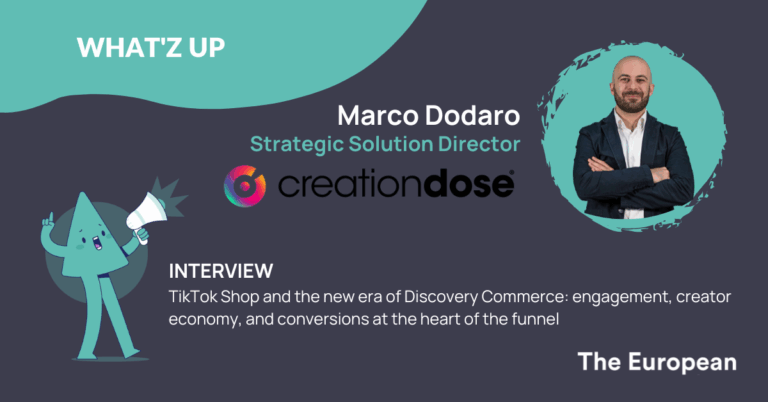
Free Hand | June 2025
CreationDose – Marco Dodaro Interview
TikTok Shop and the new era of Discovery Commerce: engagement, creator economy, and conversions at the heart of the funnel
Interview with Marco Dodaro, Strategic Solution Director at CreationDose

With TikTok Shop, advertising engagement evolves from a mere vanity metric to a concrete conversion driver. In this interview, we explore how the most dynamic social platform of the moment is rewriting the role of content and creators, shifting the focus from pure entertainment to commercial performance—within an ecosystem that is now fully full-funnel. We dive into the metrics that truly matter, the operational challenges brands face—from large-scale content production to live shopping management—and the paradigm shift needed to work with creators in an affiliate model. A strategic perspective, designed for those who need to blend branding and sales in one of the most competitive and fast-evolving contexts of digital marketing.
🗣 TikTok Shop: how is it redefining the concept of advertising engagement?
The introduction of TikTok Shop is fundamentally reshaping how advertising engagement is perceived on the platform, radically transforming TikTok’s role in the social media landscape.
With native shopping functionalities now integrated, TikTok positions itself as one of the most comprehensive social platforms globally—becoming truly full-funnel.
Before Shop, TikTok primarily excelled at the upper and mid-stages of the marketing funnel: awareness, interest, and consideration. Engagement was mostly measured via vanity metrics—views, likes, comments, shares—important indicators, but often disconnected from direct sales impact, which mostly happened off-platform.
Now, with TikTok Shop:
- The user experience is complete: users can discover a product via an organic video, ad, or live session, learn more, add it to their cart, and check out—all without leaving TikTok. This seamless journey marks a fundamental shift.
- Engagement now touches the low-funnel: the concept of engagement expands beyond superficial interaction to include concrete, measurable actions tied to the bottom of the funnel.
- Conversion-centric KPIs: the ability to track the entire user journey to purchase allows brands and advertisers to shift focus. Campaigns no longer aim only to create buzz or gain visibility—they can now be optimized and evaluated based on KPIs directly tied to conversions and advertising ROI. Engagement now includes metrics that directly impact business performance.
🗣 How is the role of creators evolving?
TikTok Shop is radically transforming the role of creators on the platform, making them integral players in the sales cycle.
Creators now play a pivotal role in users’ purchasing journeys. Their influence goes far beyond inspiration or entertainment. Thanks to features like product tags and storefronts, their recommendations can directly lead to purchases—without the user ever leaving the app.
During this feature’s consolidation phase, creators also serve an educational role. Many are creating tutorials to guide users step-by-step through the shopping functionalities—how to add items to the cart, how to complete a transaction. This not only facilitates adoption but also reinforces trust in TikTok’s integrated e-commerce system.
This model is essentially structured as affiliate marketing: creators earn commissions (typically between 10% and 20%) on the sales they generate through their content.
We’re witnessing the emergence of a new role within TikTok’s ecosystem—the affiliate creator—whose success is measured not just in terms of engagement, but in their ability to drive direct sales.
🗣 What are the key challenges brands face in activating the channel and running effective campaigns?
For brands aiming to leverage TikTok effectively—especially with the integration of Shop—several strategic and operational challenges must be addressed.
First, there’s the demand for almost mass-scale content production. The platform’s algorithm and culture reward consistency and frequency, pushing brands to create a high volume of content. What performs best on TikTok often contrasts with traditional advertising—favoring a more raw, authentic style, with a natural focus on the product. This requires a mindset shift and adaptation of internal creative processes.
Another major challenge lies in embracing affiliate marketing with creators. This model involves significant delegation: brands don’t control the final creative output. To preserve the authenticity that makes these partnerships effective, brands must accept limited oversight over messaging—trusting creators to interpret briefs genuinely. This requires trust, clear yet flexible guidelines, and tolerance for some reputational or brand coherence risks.
Lastly, managing live shopping effectively is another complex challenge. Live sessions are a powerful real-time conversion tool, but they require specific skills—live presentation, community management, real-time moderation—and introduce a much less filtered mode of communication. Brands need to be prepared, agile, and authentic to turn this channel into a true sales driver.
🗣 Can you share some best practices for an effective social commerce strategy on TikTok Shop?
Success on TikTok Shop requires a multichannel strategy combining creativity, interaction, and platform-specific functionalities. Here are some best practices:
- Create authentic, shoppable content: focus on native-style TikTok videos—spontaneous, entertaining, sometimes educational, but always authentic. Integrate products naturally, avoiding intrusive ad formats. Use product tags to make content instantly shoppable without disrupting the user experience.
- Optimize the Shop Tab: curate your profile’s Shop section carefully. Use high-quality images/videos, clear descriptions, and accurate pricing. Group products into logical categories to ease navigation.
- Leverage live shopping strategically: don’t just sell—build a community. Host themed live sessions, product Q&As, real-time demos, and exclusive live promotions. Real-time interaction builds trust and drives conversions.
- Collaborate with creators: partner with creators (via the Affiliate Program) whose audience matches your target, and whose tone aligns with your brand. Allow creative freedom to present products authentically—genuine recommendations are far more effective.
- Monitor and optimize performance: use TikTok’s analytics (for content and Shop) to identify what works. Track which videos drive product interest, which items sell the most, which creators convert best, and which shopping journeys are most efficient. Continuously refine your strategy based on these insights.
🗣 Which metrics are most indicative of success on TikTok Shop?
To properly assess your performance on TikTok Shop, focus on a set of KPIs that capture both sales volume and conversion efficiency. These can be grouped into two categories:
- Sales Metrics (measuring commercial output):
- GMV (Gross Merchandise Volume): the total value of all products sold on the platform during a given period—before fees or refunds.
- Units sold: total number of individual products sold—useful for inventory and popularity analysis.
- Orders: total number of completed transactions. One order may include multiple products.
- Buyers: unique customers who’ve made at least one purchase—helps track customer base growth.
- SKU orders: breakdown of sales by product variant (size, color, etc.)—crucial for inventory optimization.
- Refunds: volume or value of refunded orders—key for assessing customer satisfaction and product quality. High refund rates signal potential issues and impact net profitability.
- Traffic & Conversion Metrics (measuring funnel efficiency):
- Page views: total number of product page views—reflects content-driven traffic.
- Visitors: number of unique users visiting product pages—shows reach and interest.
- Conversion rate: calculated as (Orders / Visitors) × 100. A critical metric for funnel efficiency—it reflects how well your product mix, pricing, and UX convert interest into purchases.
While sales metrics capture final output, traffic and conversion indicators reveal how you’re achieving those results and how efficient your funnel is. Monitoring both is key to a comprehensive performance view.
🗣 UGCs have long been a driver of authenticity and engagement. With TikTok Shop, they become a commercial touchpoint. How does the production and management strategy change when the goal shifts from awareness to conversion?
This strategic shift can be summed up in three core points:
- Product-centric authenticity: encourage the creation of UGCs that naturally showcase the product—highlighting benefits or post-purchase experiences. These should still feel spontaneous but be inherently useful to potential buyers by preemptively answering questions and concerns.
- Strategic use for conversion: evaluate and manage UGCs not only for engagement but for their ability to build purchase intent. Amplify high-performing UGCs, integrate them into the purchase journey, and repurpose them in targeted campaigns to turn social proof into a sales engine.
- Preserve authenticity: while conversion becomes the goal, it’s critical not to compromise credibility. Avoid tactics that make UGC feel like disguised advertising—this undermines trust and, in turn, its power to influence sales.

Are you tempted by the andzup experience?
Our sales representatives are available to present the andzup solution to you in a few minutes.
© All rights reserved

